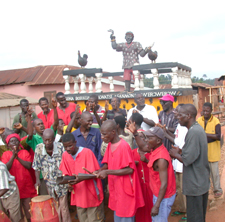Jan 25, 2016
The Asafo Flags
Every able-bodied person was expected to serve a military duty when called to action. Each township will have at least one asafo company. One's membership in an asafo company was determined by one's father's lineage (ntoro - among the Asante or egyabosom - among the Fantse). While among the Asante, women did not usually go to the war front, the Fantse had women who were war captains. The rare case of Yaa Asantewa of Edweso who led the Asante army against the British in the Yaa Asantewaa War of 1900, is well chronicled.
Asafo flags are popular among the Fantse of the coastal area. The flag is a cloth of solid color that is about three feet by five feet in dimensions. The symbols on the flag are appliqued and occasionally embroidered. The Asafo flag has on it the British flag (Union Jack) or the Ghana flag. The asafo flag bearing the Union Jack indicates the flag was made during the time that Britain ruled Ghana (Gold Coast), and the asafo flag bearing the Ghana flag indicates it was made after 1957 when Ghana gained her independence from Britain. The asafo flag with its symbols and colors often represents "important historical occasions in the life of the company or, unpleasant past events such as wars, deaths and defeats" (Labi, 1998, p. 101). As Sarbah (1906, pp. 26-27) put it, "the honour of his company flag was his first consideration and his service to his company was his indispensable service."
The asafo flag symbols are pregnant "with meaning by allusions to historical accounts, myths, rituals, sacred places, and prominent persons etc., and as such they were essential in the construction of a company's cohesion, persistence and feeling of exclusiveness; thus, to defend the cherished symbols was to defend the integrity and pride of the company" (Labi, 1998, p. 102).
The asafo are also known for their cement shrines called posuban, which may be defined as fenced-in trees and/or sacred rocks or mounds designating a god. The artistically embellished shrines attract the most attention, especially the ones that have sculptures and are multi-storied buildings. The more elaborate structures are referred to as monumental posuban.
Click here to visit gallery

